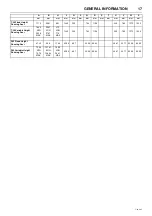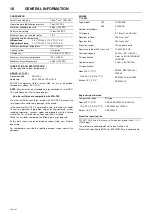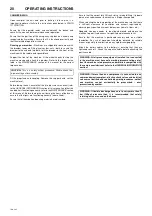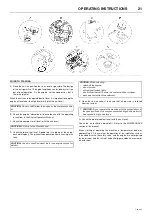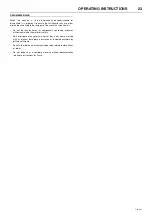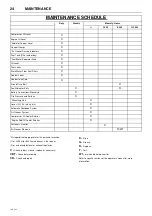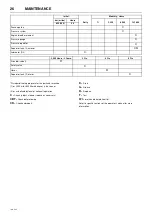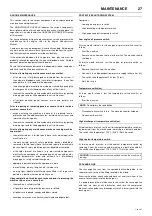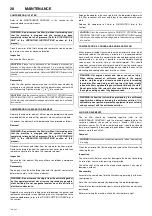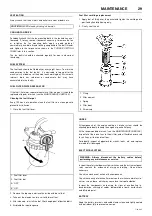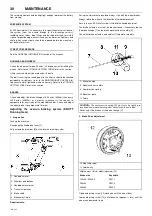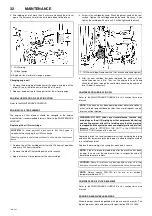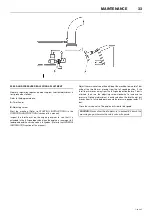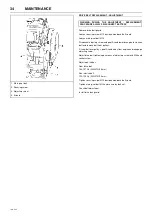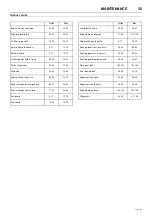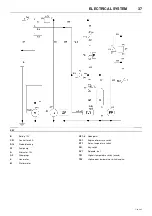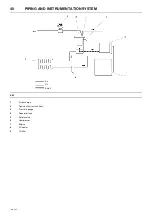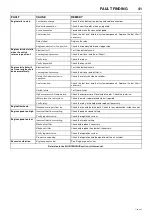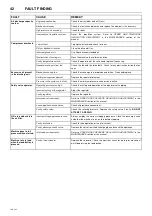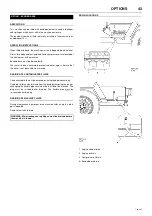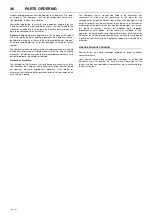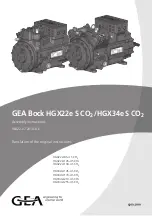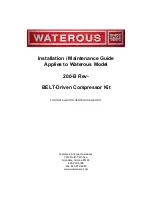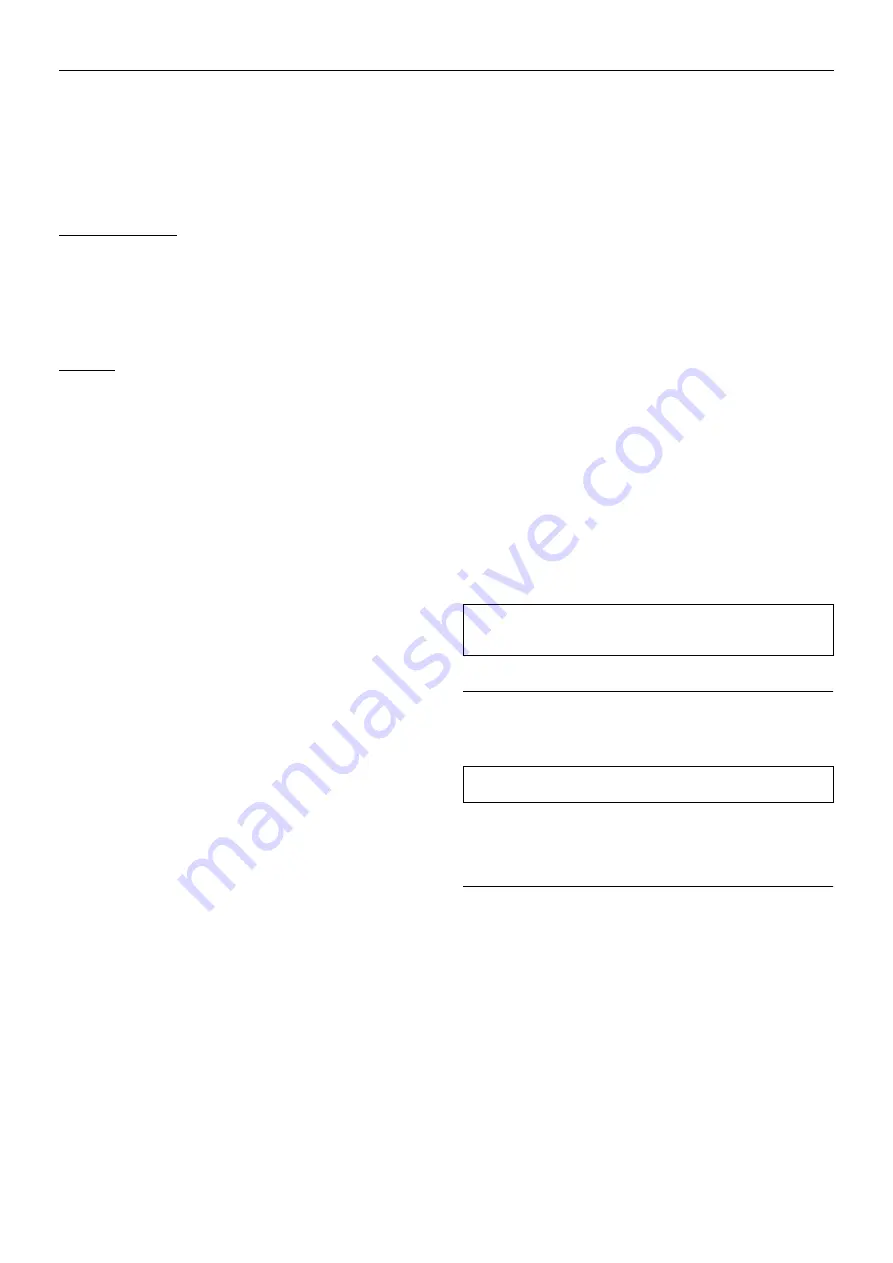
MAINTENANCE
31
7/20, P65
Slight dragging noises that do not impede the free movement of the
wheel are permissible.
This adjustment procedure must be carried out as described on both
wheel brakes.
When the brake has been adjusted accurately the actuating distance
is approximately 5-8mm on the cable [11]
3. Compensator assembly adjustment
Variable Height model
Fit an M10 safety screw to the handbrake pivot.
Disconnect the handbrake cable [5] at one end.
Pre-adjust brake linkage [7] lengthways (a little play is permissible) and
re-insert the cable [5], adjusting it to give a small amount of play.
Remove the M10 safety screw from the handbrake pivot.
All Models
Engage the handbrake lever [1] and check that the position of the
equaliser plate [10] is at right angles to the pulling direction. If
necessary correct the position of the equaliser plate [10] on the cables
[11].
The compression spring [9] must only be slightly pre-tensioned and
when engaged must not touch the axle tube.
4. Brake linkage adjustment
Adjust the brake linkage [7] lengthways without pre-tension.
Readjustment
Engage the handbrake lever [1] forcefully a number of times to set the
brake.
Check the alignment of the equalisation assembly [8], this should be at
right angles to the pulling direction
Check the play in the brake linkage [7]
If necessary adjust the brake linkage [7] again without play and without
pre-tensioning
There must still be a little play in cable [5] (Variable Height Only)
Check the position of the hand brake lever [1]. The start of resistance
should be approximately 10-15mm above the horizontal position.
Check that the wheels move freely when the handbrake is disengaged.
Final test
Check the fastenings on the transmission system (cables, brake
equalisation system and linkage).
Check the handbrake cable [5] for a small amount of play and adjust if
necessary (Variable height only)
Check the compression spring [9] for pre-tensioning.
Test run
If necessary carry out 2-3 test brake actions.
Test brake action
Check the play in brake linkage [7] and if necessary adjust the length
of brake linkage [7] until there is no play.
Apply the handbrake while rolling the machine forward, travel of the
handbrake lever up to 2/3 of maximum is allowed.
Re-adjusting the overrun braking system (KNOTT
Running Gear)
Re-adjustment of the wheel brakes will compensate for brake lining
wear. Follow the procedure described in 2: Brake Shoe Adjustment.
Check the play in the brake linkage [7] and re-adjust if necessary.
Important
Check the brake actuators and cables [11]. The brake actuators must
not be pre-tensioned.
Excessive operation of the handbrake lever, which may have been
caused by worn brake linings, must not be corrected by re-adjusting
(shortening) the brake linkage [7]
Re-adjustment
The handbrake lever [1] should be engaged forcefully several times to
set the braking system.
Check the setting of the brake equalisation assembly [8], which should
be at right angles to the pulling direction.
Check the play in the brake linkage [7] again, ensuring that there is no
play in the brake linkage and that it is adjusted without pre-tension.
Check the position of the hand brake lever [1], cable [5] (with little play)
and the compression spring [9] (only slight pre-tension). The start of
resistance of the handbrake lever should be approximately 10-15mm
above the horizontal position.
Final test
Check the fastenings on the transmission system (cables, brake
equalisation system and linkage).
Apply the handbrake while rolling the machine forward, travel of the
handbrake lever up to 2/3 of maximum is allowed.
Check the handbrake cable [5] for a small amount of play and adjust if
necessary (Variable height only).
Check the compression spring [9] for slight pre-tensioning.
LUBRICATION
The engine is initially supplied with engine oil sufficient for a nominal
period of operation (for more information, consult the
MAINTENANCE
SHEDULE
).
If, for any reason, the unit has been drained, it must be re-filled with
new oil before it is put into operation.
ENGINE LUBRICATING OIL
The engine oil should be changed at the engine manufacturer’s
recommended intervals. Refer to the
MAINTENANCE SHEDULE
.
Checking oil level and adding engine oil
1. Check the engine oil level before starting or more than 5 minutes
after stopping the engine.
2. Remove the oil level gauge, wipe it clean and reinstall it.
3. Take the oil level gauge out again, and check the oil level.
4. If the oil level is too low, remove the oil filler plug, and add new oil
to the prescribed level.
CAUTION:
Check the wheel nut torque 20 miles (30 kilometres) after
refitting the wheels (Refer to the TORQUE SETTING TABLE later in
this section).
CAUTION:
Always check the oil levels before a new machine is put
into service.
Содержание 7/20
Страница 9: ...DECALS 7 7 20 P65 Engine oil drain Cold Start Procedure...
Страница 18: ...16 GENERAL INFORMATION 7 20 P65 VARIABLE HEIGHT RUNNING GEAR FIXED HEIGHT RUNNING GEAR...
Страница 50: ......
Страница 51: ......
Страница 52: ......

